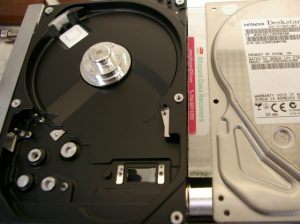 It’s a common misconception that a large percentage of hard drive data recovery cases involve removing platters. The truth is platter swapping is only necessary in a low percentage of recovery cases for most data recovery labs. For mechanical failures, the most common reason for in-lab recovery service is removal and inspection of the read/write head assembly in a clean room, with a high percentage of those cases requiring head stack replacement using spare parts.
It’s a common misconception that a large percentage of hard drive data recovery cases involve removing platters. The truth is platter swapping is only necessary in a low percentage of recovery cases for most data recovery labs. For mechanical failures, the most common reason for in-lab recovery service is removal and inspection of the read/write head assembly in a clean room, with a high percentage of those cases requiring head stack replacement using spare parts.
We have also had customers assume there is a magic machine that you put the platters on, similar to a phonograph, and it reads the data. While I am not the guy that goes around telling people there is no Santa Claus, I have to tell you there is no platter reading machine. If a hard drive has a mechanical failure, we have to temporarily fix the problem to gain access to the data. This is why parts are factored into our cost of data recovery.
The most common reason to swap platters to a new chassis is a seized motor. For this type of recovery, we have to carefully move the platters from the old chassis to a compatible donor chassis with a working and compatible spindle motor. Just because the chassis is a physical match doesn’t mean the motor is. This type of work is done in a clean room and requires delicate handling. One mistake could cause irreparable damage.
Success at physically swapping platters can be achieved with some training and practice, but there is more to the process than just the mechanics. If a lab does not have the time and resources for R&D, they are at a big disadvantage. Newer labs might lack the experience and rely on other sources for advice, which can result in a professional recovery attempt being nothing more than an experiment. Data recovery professionals should not be experimenting with customer data. At Blizzard Data Recovery, we dedicate a percentage of our time to training and R&D and have become proficient at platter swaps by working with new and used drives that were sourced specifically for training and experiments. If you are new to data recovery you might be interested in this article Data Recovery Lab Best Practices.
Once the platter(s) have been moved to a donor chassis with a working motor, we can proceed to reassemble the drive. This includes securing the platters (and dampers for some models), replacing the head assembly, ramp, filter, cover and the PCB (Or using the donor PCB with ROM swap in some cases). If everything was done correctly and the original heads were not damaged or a compatible donor HSA was installed then the process of recovering the data can proceed. As you can see, there is a lot of work involved and this is why making hard drive recovery costs affordable can be challenging.
Why do spindle motors seize? Some older drives actually have ball bearings which can fail over time due to problems caused by friction. Newer disk drives use a fluid coupled bearing which solved many issues found in the ball bearing design, but these fluid bearings might be more prone to jamming when they suffer significant impact.
You can find references to some older Seagate models that others have noticed to be prone to motor failure, but we have seen IBM/Hitachi drives with seized motors as well as some Western Digital models. Some recent models we have had in our lab that required a platter swap were Seagate ST3500320AS, Hitachi 2.5 inch HTS541616J95A00, Hitachi 3.5 inch HDP725032GLA380, Western Digital 160GB drive, and a Maxtor 30GB HDD.
How much is clean room data recovery service?
How To Select a Seagate Donor Drive